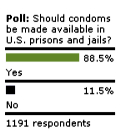Poll: Should condoms be made available in U.S. prisons and jails? [April 2007]

Poll ended April 15, 2007 |
Violent crime has fallen by 25 percent in the past 20 years, yet more Americans are now behind bars than ever before, due to policies that send nonviolent offenders to prison with longer sentences. More than 2.3 million Americans—roughly one percent of the country’s adult population—are incarcerated in U.S. state and federal prisons, according to a recent report by the Pew Center on the States. The report suggests that these inmates are at high risk of HIV infection, raising the question of whether condoms should be provided in prisons.
Although the number of HIV-positive inmates is steadily decreasing, HIV prevalence in correctional facilities is estimated to be more than five times that of the general U.S. population. Risky behaviors such as unprotected sex and injection drug use continue to fuel the epidemic in these settings.
Despite high rates of HIV, condom distribution in U.S. correctional facilities is relatively uncommon. To date, condoms are provided on a limited basis in only two state prison systems (Mississippi and Vermont) and five county jail systems (New York, Philadelphia, San Francisco, Los Angeles, and Washington, D.C.). In an effort to decrease the rates of HIV/AIDS and other sexually transmitted infections in prison settings, Representative Barbara Lee (D-CA) introduced a bill in 2006 that would permit the distribution of condoms to federal prisoners, but there has been little progress in moving it forward.
Opponents of such programs often argue that the distribution of condoms would violate prison policies that ban sexual activity. In fact in 2007, California Governor Arnold Schwarzenegger made this argument when he vetoed a bill that would have allowed condoms to be accessed in California state prisons. However, several studies have found that condom distribution did not increase sexual activity among inmates.
Critics have also raised concerns about condoms being used as a weapon or as a means to smuggle contraband. Research reveals that there have been very few instances where condoms were used to smuggle in contraband.
amfAR, in a recently released issue brief, now recommends that condoms be made available to inmates in the U.S. correctional system, in combination with HIV prevention education programs, voluntary HIV testing, addiction counseling, and mental health services.
References